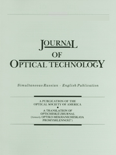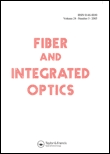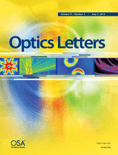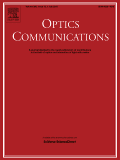
JOURNAL OF OPTICAL TECHNOLOGY
Scope & Guideline
Connecting Ideas in Optical Technology
Introduction
Aims and Scopes
- Optical Systems Design and Analysis:
Research on the design, modeling, and optimization of optical systems, including lenses, filters, and holographic elements, ensuring high performance and accuracy in various applications. - Materials for Optical Applications:
Exploration of novel materials and coatings, such as photonic crystals, nanostructured films, and advanced glass compositions, to enhance optical properties and functionalities. - Holography and Imaging Techniques:
Development and application of holographic methods for imaging, data storage, and sensing, focusing on both theoretical models and practical implementations. - Photonics and Laser Technologies:
Investigations into laser systems, including their design, modulation techniques, and applications in communication, sensing, and industrial processes. - Optical Measurement and Sensing:
Studies on optical measurement techniques, including interferometry and spectroscopy, aimed at improving the precision and capabilities of optical sensors. - Neural Networks and Computational Methods:
Application of machine learning and neural networks in optical imaging, data analysis, and system optimization, reflecting the integration of artificial intelligence in optical technology.
Trending and Emerging
- Integrated Photonics and Quantum Technologies:
Research is increasingly focusing on integrated photonics and quantum technologies, exploring their potential in communication, computing, and sensing applications, indicating a shift towards more advanced and compact systems. - Advanced Imaging Techniques:
There is a growing interest in advanced imaging techniques, including computational imaging and super-resolution methods, driven by the demand for higher resolution and more efficient imaging systems. - Machine Learning in Optics:
The application of machine learning and artificial intelligence in optics is gaining momentum, with researchers exploring its potential to enhance optical system design, image processing, and data analysis. - Sustainable Optical Materials:
A trend towards the development of sustainable and environmentally friendly optical materials is emerging, reflecting a broader awareness of environmental impacts and the push for greener technologies. - Opto-Electronic Integration:
The integration of optical and electronic components is becoming a prominent theme, with research focusing on hybrid systems that leverage the advantages of both domains for improved performance.
Declining or Waning
- Traditional Optical Communication Systems:
Research on conventional optical communication systems, which has seen reduced emphasis as newer technologies like quantum communication and advanced photonic systems gain traction. - Basic Optical Metrology Techniques:
Fundamental studies in basic optical metrology have decreased as the focus shifts toward more advanced and integrated measurement techniques that incorporate digital and computational methods. - Static Optical Elements:
The exploration of static optical elements, such as fixed lenses and traditional filters, appears to be declining as the field moves towards adaptive and dynamic optical systems. - Conventional Holography Techniques:
While holography remains an important topic, the focus on conventional methods without integration of modern technology and applications has diminished in favor of more innovative approaches.
Similar Journals

Photonics, an esteemed journal published by MDPI, is a leading platform for researchers in the fields of atomic and molecular physics, optics, and instrumentation. Since its inception in 2014, the journal has fostered open access to cutting-edge research, facilitating knowledge dissemination in these dynamic disciplines. With its Q2 ranking in the 2023 Scopus metrics for various categories, including radiology, nuclear medicine, and imaging, Photonics represents a crucial academic resource for professionals and students seeking to advance their understanding and expertise. Located in Basel, Switzerland, the journal plays a pivotal role in bridging theoretical and practical approaches to photonic technologies. Researchers are encouraged to contribute their findings, thereby enriching the journal’s impact and relevance in the global scientific community through collaboration and innovation.

FIBER AND INTEGRATED OPTICS
Pioneering Insights in Optical and Fiber SciencesFIBER AND INTEGRATED OPTICS is a prominent academic journal published by TAYLOR & FRANCIS INC, focusing on the cutting-edge domains of optical and fiber technologies. Since its inception in 1977, the journal has journeyed through expansive developments in the fields of Atomic and Molecular Physics, as well as Electronic, Optical, and Magnetic Materials, boasting a converged publication history extending to 2024. With a solid reputation reflected in its Q3 rankings in both aforementioned categories, FIBER AND INTEGRATED OPTICS serves as an essential platform for researchers, professionals, and students to disseminate and explore innovative findings and methodologies. Although currently not offering Open Access, its scholarly contributions remain invaluable, fostering a deeper understanding and advancements in fiber optic applications and integrated optical systems. Situated in the United Kingdom, the journal continues to attract a diverse global audience, solidifying its significance in contemporary scientific discourse.

OPTICS LETTERS
Pioneering Innovations in Optical ScienceOPTICS LETTERS is a premier academic journal published by the Optica Publishing Group, dedicated to advancing the field of optics and photonics. Since its inception in 1977, it has maintained a strong reputation for publishing high-impact research, holding a distinguished Q1 category ranking in Atomic and Molecular Physics, as well as Optics, making it a vital resource for researchers and professionals alike. With an impressive Scopus rank of #55 out of 224 in its field, OPTICS LETTERS continues to shape the discourse and innovation in optical science. Authors benefit from its extensive international reach, while readers gain access to cutting-edge studies that address both theoretical and applied aspects of optics. Although the journal currently does not offer open access options, its rigorous peer-review standards ensure that every publication meets the highest academic criteria, making it an essential journal for anyone looking to stay at the forefront of optical research.

OPTICAL REVIEW
Connecting Researchers in the Realm of LightOPTICAL REVIEW is a distinguished journal published by the Optical Society of Japan that serves as a critical platform for researchers, professionals, and students within the diverse fields of atomic and molecular physics and optics. With its ISSN 1340-6000 and E-ISSN 1349-9432, the journal has had a significant impact on the dissemination of knowledge since its inception in 1994, with a planned coverage until 2024. Although it currently holds a Q4 ranking in the 2023 category quartiles and is positioned at rank #152 out of 224 in the Scopus database, its contributions are vital for advancing optical science. This journal provides a venue for innovative research, review articles, and significant developments that drive the optical sciences forward. Although not categorized as Open Access, it remains an important resource for those seeking to deepen their knowledge and engage with leading-edge research in optics. With its base located at the Kudan-Kita Building in the heart of Tokyo, Germany, OPTICAL REVIEW is poised to continue fostering scholarly communication and collaboration on a global scale.

PhotoniX
Empowering Research in Optics and EngineeringPhotoniX is a premier open-access journal published by SPRINGERNATURE in Germany, dedicated to the fields of Atomic and Molecular Physics, Optics, and Electrical and Electronic Engineering. Launched in 2020, this journal has swiftly established itself as a key resource within the scientific community, achieving impressive rankings, notably being placed in the Q1 quartile across its categories in 2023. With its Scopus ranks highlighting its excellence—2nd in Engineering (Miscellaneous), 9th in Electrical and Electronic Engineering, and 6th in Atomic and Molecular Physics—PhotoniX serves as a critical platform for researchers to disseminate their findings. With an emphasis on broadening access to cutting-edge research, the journal offers a valuable opportunity for engagement with contemporary advancements in the fields it covers. Researchers, professionals, and students can benefit significantly from its contents, contributing to the collective knowledge in these vital areas of science and technology.

Current Optics and Photonics
Empowering Researchers in Optics and PhotonicsCurrent Optics and Photonics is a premier journal published by the Optical Society Korea, focusing on the dynamic and evolving fields of optics and photonics. With an ISSN of 2508-7266 and E-ISSN 2508-7274, it provides a comprehensive platform for scholarly communication, emphasizing innovations, advances in technology, and theoretical developments in atomic and molecular physics and optics. Situated in South Korea's vibrant academic landscape, this open access journal aims to bridge the gap between theoretical research and practical applications, fostering collaboration and knowledge sharing among researchers, professionals, and students alike. Although currently ranked in the Q3 category for both Atomic and Molecular Physics and Optics, with a Scopus rank of #183/224, it showcases significant contributions that enhance understanding in these critical areas. The journal encourages submission of original research articles, reviews, and technical notes, with the objective of driving forward the conversation in optics and photonics throughout its converged years from 2017 to 2024. Embrace the opportunity to contribute to this expanding field and become part of a community that is at the forefront of scientific discovery.

OPTICS COMMUNICATIONS
Illuminating the Future of Optical ResearchOptics Communications, published by Elsevier, is a prestigious international journal that focuses on the dynamically evolving fields of optics and photonics. With its ISSN 0030-4018 and E-ISSN 1873-0310, this journal has made significant contributions to the fields of Atomic and Molecular Physics, Electrical and Electronic Engineering, Electronic, Optical and Magnetic Materials, and Physical and Theoretical Chemistry, consistently ranking in the Q2 quartile across these categories for 2023. The journal, based in the Netherlands, is recognized for its rigorous peer-review process and aims to publish high-quality research articles that advance knowledge and applications in optical communication technologies. Although it operates under a subscription model, the insightful research published here plays an essential role in informing the work of researchers, professionals, and students alike. With a history dating back to 1969 and spanning well into 2025, Optics Communications remains a crucial resource for cutting-edge developments in optics, catering to a global audience dedicated to innovation in this pivotal science.

JOURNAL OF RUSSIAN LASER RESEARCH
Pioneering Research in Optics and EngineeringThe Journal of Russian Laser Research, published by Springer, stands as a vital resource for researchers and professionals in the fields of atomic and molecular physics, as well as optics and engineering. With its ISSN 1071-2836 and E-ISSN 1573-8760, this journal has been disseminating groundbreaking research since its inception in 1994, with a dedicated focus on the advancement of laser technologies and their applications. While it currently holds a Q4 classification in both Atomic and Molecular Physics and Engineering categories, its commitment to fostering novel insights and innovative methodologies positions it as a promising platform for emerging studies within these disciplines. Although the journal does not offer open access options, it continues to draw attention with a growing citation index. By publishing diverse research articles, reviews, and critical discussions, the Journal of Russian Laser Research not only enriches academic literature but also serves as a stepping stone for students and professionals seeking to deepen their understanding of laser science and its myriad applications.

Acta Photonica Sinica
Exploring the Depths of Optical InnovationActa Photonica Sinica is a peer-reviewed academic journal published by SCIENCE PRESS, focusing on the fields of atomic and molecular physics and optics. Since its inception in 1997, this journal has provided a crucial platform for researchers and professionals to share cutting-edge findings and advancements in photonics and related areas. Despite its current positioning in the Q4 quartile for both atomic and molecular physics and optics, Acta Photonica Sinica remains a significant contributor to the scholarly community, fostering innovative discussions and collaborations. The journal does not currently offer open access, providing a selective but impactful repository of knowledge for readers in China and beyond. As the scientific landscape evolves, the journal aims to enhance its scope and impact, addressing the challenges and opportunities within the photonics domain. Researchers, students, and professionals interested in the latest theoretical and experimental studies will find a wealth of information that emphasizes the pivotal role of optics in scientific and technological advancements.

JOURNAL OF MODERN OPTICS
Bridging Theory and Practice in Modern OpticsJOURNAL OF MODERN OPTICS, published by Taylor & Francis Ltd, stands as a prominent bi-monthly journal contributing to the fields of Atomic and Molecular Physics and Optics. With an ISSN of 0950-0340 and an E-ISSN of 1362-3044, this journal aims to disseminate high-quality research that pushes the boundaries of optical science and its applications. Since its inception in 1981, and particularly throughout its publications from 1987 to 2024, the journal has consistently published influential studies that are essential for both academic researchers and industry professionals. Ranked in the Q3 quartile for the 2023 category of Atomic and Molecular Physics and Optics, it has a Scopus ranking of #133 out of 224, indicating its steady presence and relevance in the scientific community. Although it does not offer Open Access options, readers can access its rich repository of literature that delves into innovative optical methods, technological advancements, and theoretical frameworks. The JOURNAL OF MODERN OPTICS is an indispensable resource for those seeking to advance their knowledge and research in modern optical science.